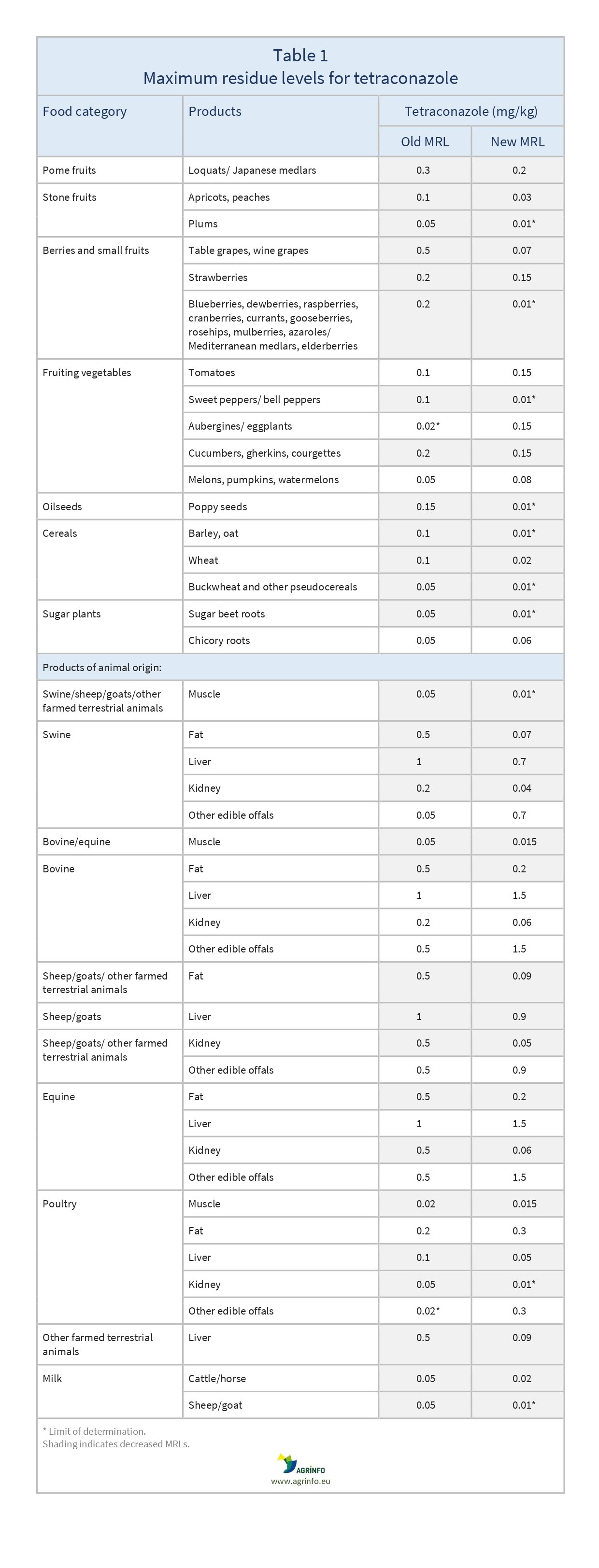Maximum residue levels for tetraconazole
- Pesticide MRLs
Summary
The EU has amended the MRLs for tetraconazole on many products, with implications for certain fruit, vegetables, oilseeds, cereals, sugar plants and animal products.
EU amends MRLs for tetraconazole, with implications for certain fruit, vegetables, oilseeds, cereals, sugar plants and animal products
Commission Regulation (EU) 2023/466 of 3 March 2023 amending Annexes II, III and V to Regulation (EC) No 396/2005 of the European Parliament and of the Council as regards maximum residue levels for isoxaben, novaluron and tetraconazole in or on certain products
Update
The EU has amended the MRLs for tetraconazole on many products, with implications for certain fruit, vegetables, oilseeds, cereals, sugar plants and animal products.
Impacted Products
loquats, Japanese medlars, apricots, peaches, plums, table grapes, wine grapes, strawberries, blueberries, dewberries, raspberries, cranberries, currants, gooseberries, rosehips, mulberries, azaroles, Mediterranean medlars, elderberries, tomatoes, sweet peppers, bell peppers, aubergines, eggplants, cucumbers, gherkins, courgettes, melons, pumpkins, watermelons, poppy seeds, barley, oat, wheat, buckwheat, sugar beet roots, chicory roots, animal products
What is changing?
The changes to MRLs are set out in Table 1.
Why?
Following a review of existing tetraconazole MRLs (EFSA 2022), EFSA proposed the reduction of MRLs in a range of fruits, vegetables and products of animal origin. Other MRLs could be maintained or raised on the basis of current good agricultural practices.
Timeline
The new MRLs apply from 26 September 2023. For products exported before that date, the old MRLs still apply.
Recommended Actions
The MRLs have been amended (both raised and lowered) on a range of products. Suppliers to the EU market of fruit and vegetables, cotton seeds, sugarcane and animal products should carefully review the changes proposed.
Suppliers of products with MRLs reduced to the limit of determination (LOD, the lowest level that can be detected using the most modern and reliable analytical methods) should seek alternative solutions to tetraconazole.
Background
MRLs are set in accordance with the rules set out in Regulation 396/2005. For information on current MRLs for other substances, please consult the EU Pesticide Residues database.
Resources
EFSA (2022) Review of the existing maximum residue levels for tetraconazole according to Article 12 of Regulation (EC) No 396/2005. EFSA Journal, 20(1): 7111.
Sources
Commission Regulation (EU) 2023/466
Tables & Figures

Commission Regulation (EU) 2023/466
Disclaimer: Under no circumstances shall COLEAD be liable for any loss, damage, liability or expense incurred or suffered that is claimed to have resulted from the use of information available on this website or any link to external sites. The use of the website is at the user’s sole risk and responsibility. This information platform was created and maintained with the financial support of the European Union. Its contents do not, however, reflect the views of the European Union.
